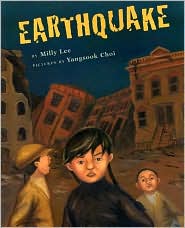Well, we're finally moving on to story elements! This year, I'm trying to work on two thorny setting issues--the issue of multiple locations in one story and the issue of understanding time as a component of setting.
Problem 1: Multiple locations
In the primary grades, setting is often described as one location--the barnyard or the house or the playground. As students get older, though, they often have to describe more complex settings. A story might start in one location, and then move. The reader needs to collapse this list of different places into one overall setting.
Today, I started by practicing collapsing lists with my students. We started with easy ones: mango, pineapple, orange, apple (fruit); basketball, softball, golf, tennis (sports); table, chair, lamp, sofa (furniture). Then we looked at how this could work with setting: hallway, cafeteria, library, classroom (school).
To show students how this works with a text, we read the book Earthquake by Milly Lee. I love this book because it tells the story of the San Francisco earthquake in a very simple, powerful way. And "San Francisco" never appears in the main text!
We made a list of the locations shown on different pages: the family's living room, their apartment, the street, Chinatown, Golden Gate Park. Then, we tried to collapse the list. This required them to pull on their background knowledge. (We had read a play about the San Francisco earthquake the week before.) Some groups pulled on this experience, while others used their knowledge of the Golden Gate Bridge. The important thing, however, was that they were able to collapse the list of small locations into one main setting.
I love how simple this lesson was, and yet how important. It brings together the idea of collapsing lists with making inferences with story elements. Wonderful!
Problem 2: Setting as time
Well, the setting is the time AND place of the story. But many readers are a little too literal with their statement of time. Instead of "1906" as the time for Earthquake, a reader might write, "in the night and the next morning." This is a big problem, because a reader who is thinking of time on such a micro-level may not notice important dates and might fail to add big ideas to their schema.
I decided to make a graphic organizer to show a timeline. When I handed it out to students, I didn't explain anything--I just said, "What do you notice?" Working with their partners, they found all of the important elements: that it shows how time goes in one direction, that there are little pictures to show past, present, and future, that it includes words to help you find the time of a text.
What about fairy tales? It's so hard to show how they fit in. I decided to show how they are off the timeline. Fairy tales and fantasy take place in another time, often with elements of the past mixed in.
After we read Earthquake, we talked about how the setting is not just the location, but also the time. Students easily found that it took place in the past--once again, by drawing on their background knowledge.
I love it when things come together in one lesson. And a great book makes it happen even more easily!



No comments:
Post a Comment